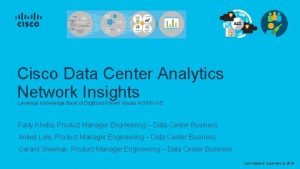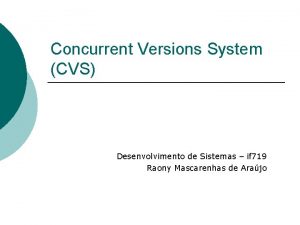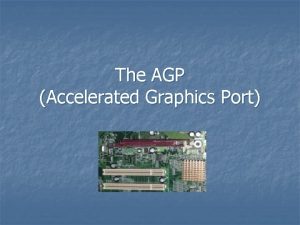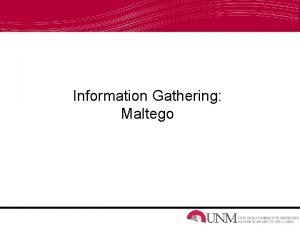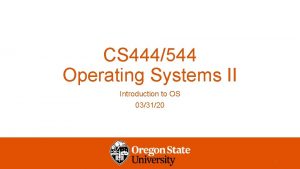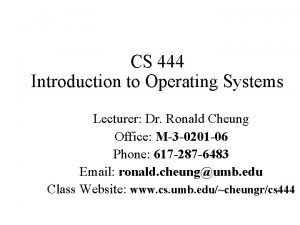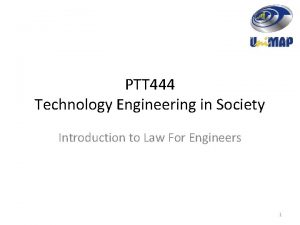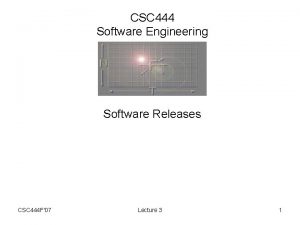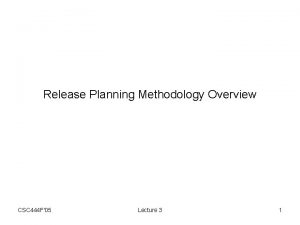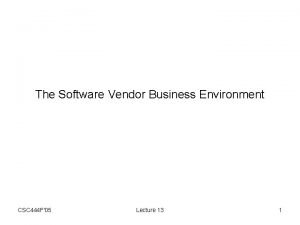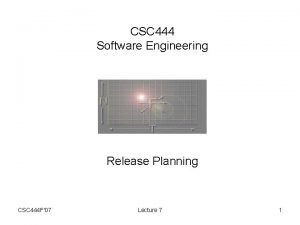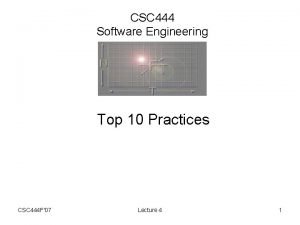Releases and Versions CSC 444 F05 Lecture 6


















- Slides: 18

Releases and Versions CSC 444 F'05 Lecture 6 1

MIDTERM NEW DATE AND TIME AND PLACE Tuesday, November 1 8 pm to 9 pm Woodsworth College WW 111 CSC 444 F'05 Lecture 6 2

Concepts & Terminology CSC 444 F'05 Lecture 6 3

Cost of Feature Releases • Considerable overhead associated with a feature release: – – – – • System testing Marketing collateral Launch events Customer/partner briefings New training courses and materials New training internally New CD’s to burn. . . Largest cost of them all – Increased maintenance burden from supporting an extra release in the field • • • Reproduce bug in each codeline Decide what/when to fix Re-test Re-release Maintenance releases are much less costly – Regression tests will do it CSC 444 F'05 Lecture 6 4

Supporting Simultaneous Releases • Generally must support at least 2 feature release maintenance streams. • Usually must support 3. • MUST try to hold the line at 3. • Else all the maintenance will erode the company’s ability to respond in a timely fashion to changing market conditions. • Opportunity cost of developers – A trained developer is scarce resource – New features or maintenance – Opportunity cost of maintenance is the revenue the feature they might have coded could have brought in. CSC 444 F'05 Lecture 6 5

maintenance R 1 shipping R 1. 0 private big new feature X retired shipping R 1. 1 maintenance R 2 shipping R 2. 0 shipping R 2. 1 maintenance R 3 shipping R 3. 0 shipping R 2. 2 shipping R 1. 1 R 2. 2. a ongoing CSC 444 F'05 active Lecture 6 6

Time Between Releases • Feature releases are costly: – Therefore increase the time between feature releases. • But, customers want more features – Therefore decrease the time between feature releases • But, they also want stability in their own IT environment – Therefore increase the time between feature releases. – Sometimes customers get very sticky on old releases – Need to make the new release compelling to end-users • What if one customer or prospect wants a new feature? – New feature release? – Probably not • What if the market condition changes rapidly? – Cut short current release to rush it out? – Go back to last release, extend it, and put that out? – Costly: because of short release cycle will need to support >3 releases in the field. CSC 444 F'05 Lecture 6 7

Pushing Back • A successful development manager will need to distinguish between people asking for things that can be pushed off, and truly urgent things. – Everything is presented as the latter • Track the request back to its source personally. – Will learn the true nature of thee request. – Can deal with 80% of “urgent” requests in this manner CSC 444 F'05 Lecture 6 8

Features in Maintenance Releases • Tried pushing back • Cannot justify a new feature release • Customer/prospect still wants/needs features earlier than the next scheduled feature release • What now? • Slip new features into a maintenance release. • In theory, maintenance releases should change no externally visible program behavior (other than to correct it if faulty). • What the heck, do it anyways. • Does not have the cost of a new feature release. • Why not? CSC 444 F'05 Lecture 6 9

Costs of Features in Maintenance Releases • BASIC RULE: – Cannot introduce new code without introducing new defects • Two reasons for introducing new code: – Fix a defect – Code a feature • If only doing defect corrections: – Fix 2 add 1: the trend is good: -1 – Will eventually get them all (asymptotically) – Converging quality • If also doing new features: – Fix 2 add 1, add a new feature, add 4: the trend is poor: +3 – Diverging quality CSC 444 F'05 Lecture 6 10

Negative Leveraging • The new feature is only useful to one customer. • The defects introduced as a result can negatively impact every customer. • Because touching code risks breaking ANYTHING, ANYWHERE • Customers get irate if a “maintenance release” breaks previously working functionality – Danger even when just fixing defects – Gets much worse if adding features CSC 444 F'05 Lecture 6 11

Release Proliferation • If software quality is poor in general, customers will be slow to upgrade to a release they consider will be more buggy. – Can lead to supporting many releases in the field. • EVEN WORSE: If customers come to fear maintenance releases, they may be reluctant to leave a maintenance release. – They may insist that you fix any issues as patches to their maintenance release – This is catastrophic release proliferation, whereby every point releases turns into a maintenance stream of its own. . . CSC 444 F'05 Lecture 6 12

Mitigating the Consequences • If absolutely forced to, then: • Have a very good regression testing environment • Segregate functionality using run-time configuration switches – Code review to ensure when off, no new code touches the system CSC 444 F'05 Lecture 6 13

Versions • As distinguished from “releases”. • Different variants of the same software – Differ in small ways Must Support: • stream of maintenance releases for each version • each feature release will continue to ship that version • ideally at the same time Version reasons: Hard to Undo the decision to support a new version: • some customer now relies on it CSC 444 F'05 Lecture 6 • multiple hardware platforms • multiple os’s • multiple databases • multiple app frameworks • multiple partner software • security • functional tiers • demoware • translations 14

Cost of Versions • Surprisingly costly to support many versions – Not the development cost: relatively cheap – just another feature – Ongoing maintenance costs • Technical means: – different code (linked differently or #ifdef’d) – run-time switches (e. g. , dynamically detect version of Windows and change API calls appropriately). – different dev platform and tools – binary-compatible: different test environments • In any case: – testers must test all supported versions – coders must bear in mind they are supporting multiple versions – must track down bugs in each version and fix CSC 444 F'05 Lecture 6 15

Version Proliferation • Software company will support many versions in hopes sales will increase – each version opens up a new market segment • Danger: too hastily commit to supporting too many versions • Be aware of costs and push-back • If in the business of supporting many versions: – architect the software well to support it – construct a superb multi-platform automated build/test environment CSC 444 F'05 Lecture 6 16

Customized Software • A different variant of the software for important customers – Static methods: require a distinct executable – Dynamic methods: same executable • run-time switches • alternate dll’s • If customization required on feature release boundary – evaluate if feature’s dev opportunity costs are worth the revenue • If customization required sooner – either: • carefully insert changes into the point release stream • #ifdef all code and build a unique executable for the customer – Can we merge the changes into the next feature release? – Nothing very palatable here • Better to build in enough configurability that customers do not require customizations – gui-based configuration – scripting-based configuration CSC 444 F'05 Lecture 6 17

User Extension API • Allows customers to implement their own features into the software • Danger: – must support the API forever more – even if one already exists internally: • • • clean it up identify public versus private APIs document it train customers on it hire programmers to provide help desk support on it – support becomes “debug the customer’s code” • maintain it unchanged – do not inadvertently change behavior • market it and sell it • consult on it – write it once – support it forever? » paid/unpaid? CSC 444 F'05 Lecture 6 18
 01:640:244 lecture notes - lecture 15: plat, idah, farad
01:640:244 lecture notes - lecture 15: plat, idah, farad Cellular respiration releases
Cellular respiration releases Cellular respiration releases
Cellular respiration releases Network insights cisco
Network insights cisco Which structure releases glucagon
Which structure releases glucagon The yucca plant releases a strong scent at night
The yucca plant releases a strong scent at night The yucca plant releases a strong scent at night
The yucca plant releases a strong scent at night Concurrent versions system
Concurrent versions system Gender roles in snow white
Gender roles in snow white Accelerated graphics port
Accelerated graphics port What is maltego
What is maltego 5 rows and 2 columns
5 rows and 2 columns Spm list
Spm list Sic architecture
Sic architecture 444 5 lecke
444 5 lecke 444 555 666 888 33 88 artinya
444 555 666 888 33 88 artinya Cs 444 oregon state
Cs 444 oregon state Cs444 umb
Cs444 umb Ptt 444
Ptt 444



